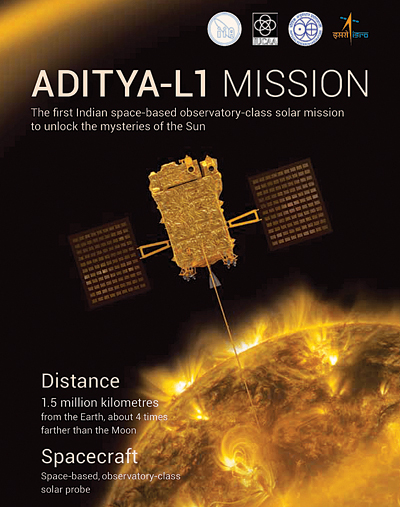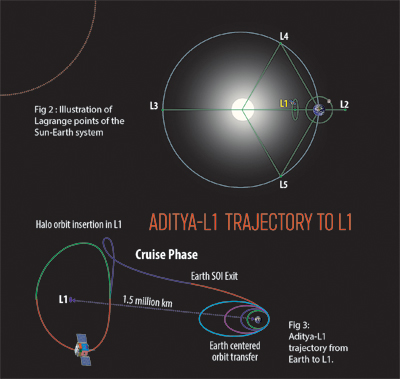INDIAN ARMED FORCES CHIEFS ON
OUR RELENTLESS AND FOCUSED PUBLISHING EFFORTS

SP Guide Publications puts forth a well compiled articulation of issues, pursuits and accomplishments of the Indian Army, over the years

I am confident that SP Guide Publications would continue to inform, inspire and influence.

My compliments to SP Guide Publications for informative and credible reportage on contemporary aerospace issues over the past six decades.
India’s First Solar Observatory Headed to its Destination
The satellite will be positioned in a halo orbit around the L1 of the Sun-Earth system, approximately 1.5 million kilometers from Earth

In a significant stride for India’s space programme, following the successful Chandrayaan-3 mission to the moon, the nation is now embarking on a journey toward the sun with Aditya-L1. Launched on September 2, 2023, aboard the PSLV-C57 rocket, Aditya-L1 is a dedicated satellite designed for an in-depth study of the Sun. The satellite boasts seven distinct payloads, five of which are developed by the Indian Space Research Organisation (ISRO), with the remaining two being a collaborative effort between Indian academic institutes and ISRO.
Aditya-L1 is India’s inaugural space-based mission dedicated to the study of the Sun. Aditya, meaning “Sun” in Sanskrit, derives its name from its mission to study the Sun. The “L1” signifies its destination: the Lagrange Point 1 of the Sun-Earth system. For context, L1 is a unique location in space where the gravitational forces of two celestial bodies, in this case, the Sun and Earth, are perfectly balanced. This equilibrium enables an object positioned at L1 to remain relatively stable concerning both celestial bodies.

The journey of India’s first solar observatory commenced with the launch of Aditya-L1. Following liftoff, the satellite is to remain in Earth-bound orbits for 16 days. During this period, it will execute five maneuvers to attain the necessary velocity for its interplanetary journey. On September 3, 2023, just a day after launch, the first Earth-bound maneuver was successfully executed at ISTRAC, Bengaluru, followed by the second on September 5, 2023, and the third on September 10, 2023.
Subsequently, Aditya-L1 will embark on a Trans-Lagrangian1 insertion maneuver, marking the commencement of its 110-day trajectory towards the L1 Lagrange point. Upon reaching the L1 point, another maneuver would bind Aditya-L1 to an orbit around L1, a region of gravitational equilibrium situated between Earth and the Sun. Throughout its mission, the satellite orbits L1 in an irregularly shaped path, roughly perpendicular to the line connecting Earth and the Sun. The satellite will be positioned in a halo orbit around the Lagrange point 1 (L1) of the Sun-Earth system, approximately 1.5 million kilometers from Earth. This unique vantage point offers continuous, uninterrupted observations of the Sun without eclipses or occultations, providing real-time insights into solar activities and their impact on space weather.
To study how solar wind particles and magnetic fields travel through interplanetary space, measurements must be taken from a location far removed from Earth’s magnetic field
The satellite’s strategic location at the L1 Lagrange point ensures constant surveillance of the Sun and access to solar radiation and magnetic storms before they are influenced by Earth’s magnetic field and atmosphere. Additionally, the stability of the L1 point minimises the need for frequent orbital adjustments, optimising the satellite’s operational efficiency.
In an exciting development, ISRO shared an image taken by Aditya-L1 on September 7, 2023, of Earth and the moon. The selfie image also showcased a portion of the spacecraft including the Visible Emission Line Coronagraph (VELC) and the Solar Ultraviolet Imaging Telescope (SUIT) instruments.
ADITYA-L1 PAYLOADS
Equipped with seven payloads, Aditya-L1 will observe the photosphere, chromosphere, and the outermost layers of the Sun’s corona using electromagnetic, particle, and magnetic field detectors.
- VELC: Visible Emission Line Coronagraph is designed to study solar corona and dynamics of coronal mass ejections. The payload is developed by the Indian Institute of Astrophysics, Bengaluru in close collaboration with ISRO.
- SUIT: Solar Ultra-violet Imaging Telescope to image the Solar Photosphere and Chromosphere in near Ultra-violet (UV) and, to measure the solar irradiance variations in near UV. The payload is developed by the Inter-University Centre for Astronomy and Astrophysics, Pune in close collaboration with ISRO.
- SoLEXS HEL1OS: Solar Low Energy X-ray Spectrometer and High Energy L1 Orbiting X-ray Spectrometer are designed to study the X-ray flares from the Sun over a wide X-ray energy range. Both these payloads are developed at U R Rao Satellite Centre, Bengaluru.
- ASPEX PAPA: Aditya Solar Wind Particle EXperiment and Plasma Analyser Package for Aditya payloads are designed to study the solar wind and energetic ions, as well as their energy distribution. ASPEX PAPA was developed at the Physical Research Laboratory, Ahmedabad. PAPA is developed at Space Physics Laboratory, Vikram Sarabhai Space Centre, Thiruvananthapuram.
- MAG: Magnetometer payload is capable of measuring interplanetary magnetic fields at the L1 point. The payload is developed at Laboratory for Electro-Optics Systems, Bengaluru. Aditya-L1’s payloads are expected to provide critical data on various solar phenomena, including coronal heating, coronal mass ejections, solar flares, solar wind dynamics, and magnetic field measurements in the solar corona.
Major science objectives of Aditya-L1 include:
- Understanding the Coronal Heating and Solar Wind Acceleration
- Understanding initiation of Coronal Mass Ejection (CME), flares, and nearearth space weather
- To understand the coupling and dynamics of the solar atmosphere
- To understand solar wind distribution and temperature anisotropy.
WHY STUDY THE SUN?
Studying the Sun holds immense significance as it is the closest star, offering insights into the workings of stars in our Milky Way and other galaxies. The Sun’s dynamic nature, including eruptive phenomena and the release of vast energy into the solar system, necessitates scientific exploration. Understanding solar phenomena is crucial for mitigating their potential impact on Earth, including disturbances to spacecraft and communication systems, as well as threats to astronauts. The extreme thermal and magnetic conditions of the Sun also serve as a natural laboratory for studying phenomena impossible to replicate in a controlled laboratory environment.
L1 is a unique location in space where the gravitational forces of two celestial bodies, in this case, the Sun and Earth, are perfectly balanced

Observing the Sun from space is essential because the Earth’s atmosphere and magnetic field block many harmful solar radiations, making space-based observations necessary. Additionally, to study how solar wind particles and magnetic fields travel through interplanetary space, measurements must be taken from a location far removed from Earth’s magnetic field, hence Aditya-L1 will be observing the Sun from the L1 point.
The Sun’s constant emissions, including radiation, heat, particles, and magnetic fields, significantly influence Earth and other planets. The solar wind, composed mostly of high-energy protons, fills the entire known solar system and can affect the space environment near planets. Solar events like Coronal Mass Ejections (CMEs) and solar flares can disrupt the Earth’s magnetic field and impact the functioning of space assets. Understanding space weather is crucial as we rely increasingly on technology in space, and insights into near-Earth space weather can provide insights into the behavior of space weather on other planets.
WHAT MAKES ADITYA-L1 UNIQUE?
- First-time spatially resolved solar disk in the near UV band
- CME dynamics close to the solar disk (∼ from 1.05 solar radius) thereby providing information in the acceleration regime of CME, which is not observed consistently
- Onboard intelligence to detect CMEs and solar flares for optimised observations and data volume
- Directional and energy anisotropy of solar wind using multi-direction observations.
Aditya-L1’s mission to study the Sun from space represents a significant step in advancing our understanding of solar phenomena and their impact on space weather. This pioneering endeavor will also harness India’s technical prowess and contribute to global efforts to comprehend the Sun’s complex dynamics, ultimately benefiting space exploration and our knowledge of stars beyond our solar system.





